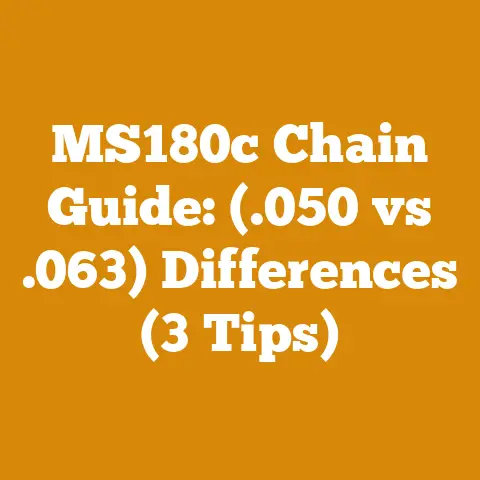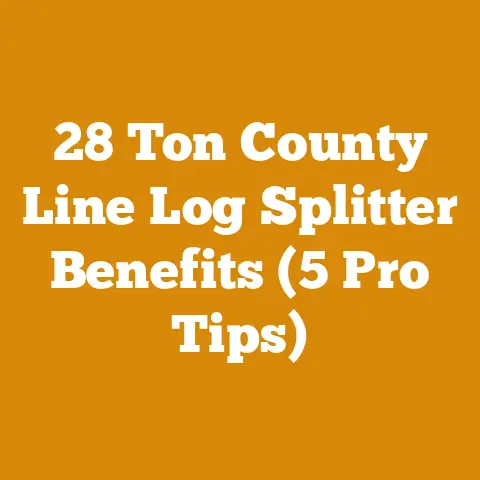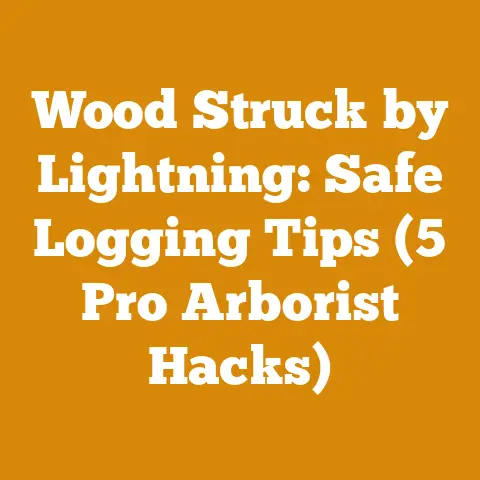Jonsered 2135 Top Handle Saws (5 Pro Tips for Safe Cutting)
Jonsered 2135 Top Handle Saws: 5 Pro Tips for Safe Cutting
In recent years, I’ve observed a significant shift in how people approach wood processing and firewood preparation. There’s a growing demand for efficiency, safety, and precision, especially among hobbyists and small contractors. The Jonsered 2135 top handle chainsaw has emerged as a popular choice for its lightweight design and maneuverability, making it ideal for tasks like pruning, limbing, and small-scale felling. However, its top-handle design requires a different approach to safety and technique compared to rear-handle models. This guide, based on my years of experience in the field, provides five pro tips to ensure safe and effective cutting with the Jonsered 2135, or similar top-handle saws.
Understanding the Jonsered 2135: A Brief Overview
Before diving into the tips, let’s briefly understand the Jonsered 2135. It’s a lightweight (around 3.4 kg or 7.5 lbs without bar and chain), gasoline-powered chainsaw with a 34.4 cc engine. The top-handle design allows for greater reach and maneuverability, particularly when working at height. However, this design also shifts the center of gravity, making it more prone to kickback and requiring a firmer grip and greater operator awareness.
Key Terms:
- Kickback: The sudden and uncontrolled backward and upward movement of the chainsaw bar, often caused when the tip of the bar contacts an object.
- Limbing: Removing branches from a felled tree.
- Pruning: Selectively removing branches from a live tree.
- Felling: Cutting down a tree.
- Green Wood: Freshly cut wood with a high moisture content (typically above 30%).
- Seasoned Wood: Wood that has been air-dried or kiln-dried to a lower moisture content (typically below 20%).
Pro Tip 1: Master the One-Handed Myth and Two-Handed Grip
A common misconception is that top-handle chainsaws are designed for one-handed operation. While they can be used one-handed in very specific and controlled situations (primarily for tree care professionals trained in aerial lift environments), I strongly advise against it for general use. The Jonsered 2135, like any chainsaw, is most safely and effectively operated with both hands whenever possible.
Why Two Hands Are Crucial:
- Control: Two hands provide significantly better control over the saw, reducing the risk of kickback and accidental cuts.
- Stability: A firm grip with both hands stabilizes the saw, especially when cutting at awkward angles.
- Reduced Fatigue: Distributing the weight of the saw between both arms reduces fatigue, allowing you to work longer and more safely.
The Correct Two-Handed Grip:
- Right Hand: Firmly grip the rear handle, ensuring your thumb wraps completely around the handle.
- Left Hand: Grip the top handle with your palm facing downwards. Ensure your thumb is also wrapped around the handle.
- Stance: Maintain a balanced stance with your feet shoulder-width apart. Keep your knees slightly bent to absorb vibrations and maintain stability.
One-Handed Exception (For Trained Professionals Only):
I’ve seen arborists use one hand briefly while secured in a tree, but this requires extensive training and specialized equipment. The other hand is used for balance and securing themselves. This is not recommended for general users. My experience in tree care has shown me that even seasoned professionals can have accidents when using a chainsaw one-handed.
Personal Story:
I once witnessed a colleague, a very experienced arborist, suffer a minor injury while attempting a one-handed cut from a bucket truck. He was reaching for a small branch and momentarily lost his balance. While the injury was not severe, it served as a stark reminder of the risks involved in one-handed chainsaw operation.
Pro Tip 2: Prioritize Personal Protective Equipment (PPE)
Chainsaw safety begins with proper PPE. I cannot stress this enough. It’s not just about following regulations; it’s about protecting yourself from serious injury.
Essential PPE:
- Chainsaw Helmet: A helmet with a face shield and ear protection is crucial. The face shield protects your eyes from flying debris, while the ear protection reduces the risk of hearing damage. I recommend a helmet meeting ANSI Z89.1 standards.
- Eye Protection: Even with a face shield, wear safety glasses or goggles underneath. This provides an extra layer of protection against fine particles that can penetrate the shield. Look for glasses meeting ANSI Z87.1 standards.
- Hearing Protection: Chainsaws are loud. Prolonged exposure to high noise levels can lead to permanent hearing loss. Use earplugs or earmuffs with a Noise Reduction Rating (NRR) of at least 25 dB.
- Chainsaw Chaps or Trousers: These are made of ballistic nylon or Kevlar and are designed to stop the chain in the event of contact with your leg. Chaps should cover the entire front of your legs, from the groin to the top of your boots. Trousers offer all-around protection. I prefer chaps for their versatility and ease of use. Look for chaps meeting ASTM F1897 standards.
- Chainsaw Gloves: Gloves provide a firm grip and protect your hands from cuts, abrasions, and vibrations. Look for gloves with reinforced palms and vibration-dampening features.
- Chainsaw Boots: Sturdy boots with steel toes and chainsaw-resistant uppers are essential for protecting your feet. Look for boots meeting ASTM F2413 standards.
- First-Aid Kit: Keep a well-stocked first-aid kit readily available in case of an accident. Include items such as bandages, antiseptic wipes, gauze pads, and a tourniquet.
Data-Driven Insight:
According to the U.S. Consumer Product Safety Commission, chainsaw-related injuries result in tens of thousands of emergency room visits each year. Wearing proper PPE can significantly reduce the severity of these injuries.
Cost Analysis:
While PPE can seem expensive, consider it an investment in your safety. A good-quality chainsaw helmet can cost around $100-$200, chaps around $80-$150, and boots around $150-$300. Compared to the cost of medical bills and lost wages from a chainsaw injury, PPE is a bargain.
Pro Tip 3: Master the Art of the Bore Cut (For Felling Small Trees)
The bore cut is an advanced felling technique that can be particularly useful when working with smaller trees using the Jonsered 2135. It allows you to control the direction of the fall more precisely and reduce the risk of pinching the bar. This technique requires experience and should only be attempted by experienced chainsaw operators.
Understanding the Bore Cut:
The bore cut involves plunging the tip of the chainsaw bar into the trunk of the tree, creating a “bore” or tunnel. This allows you to cut the hinge wood (the wood that controls the direction of the fall) from the inside out, giving you greater control.
Step-by-Step Guide:
- Assess the Tree: Before starting, carefully assess the tree for lean, wind direction, and any potential hazards (e.g., power lines, other trees).
- Clear the Area: Remove any obstacles from the felling zone.
- Make the Face Cut: Cut a notch on the side of the tree in the direction you want it to fall. The notch should be about one-third of the tree’s diameter.
- Start the Bore Cut: Stand to the side of the tree, never directly behind it. Carefully plunge the tip of the chainsaw bar into the trunk, a few inches behind the face cut. Use the bumper spikes to stabilize the saw.
- Create the Bore: Once the bar is fully inserted, pivot the saw to create a horizontal cut towards the back of the tree, leaving a hinge of wood.
- Cut the Hinge: Carefully cut the hinge wood, leaving enough to control the fall. The thickness of the hinge depends on the size of the tree and the desired speed of the fall.
- Make the Felling Cut: Once the hinge is cut, make the final felling cut from the back of the tree, leaving a small amount of wood to prevent premature falling.
- Wedge (Optional): If the tree is leaning against the desired direction of fall, use a felling wedge to help push it over.
- Retreat: As the tree begins to fall, immediately retreat away from the base of the tree at a 45-degree angle.
Safety Precautions:
- Kickback: The bore cut is more prone to kickback than other cutting techniques. Be extremely careful when plunging the bar into the wood. Maintain a firm grip and keep the chain sharp.
- Pinching: The bar can get pinched during the bore cut. Use wedges to prevent pinching, especially when felling trees with internal tension.
- Experience: The bore cut requires experience and a good understanding of chainsaw operation. If you are not comfortable with this technique, do not attempt it.
Case Study:
I once used the bore cut to fell a small, leaning tree near a building. The limited space made a traditional felling cut impossible. By using the bore cut, I was able to precisely control the direction of the fall and avoid damaging the building.
Measurement and Specification:
- Hinge Thickness: The hinge should be approximately 10% of the tree’s diameter.
- Face Cut Angle: The angle of the face cut should be approximately 45 degrees.
Pro Tip 4: Sharpening and Maintaining Your Jonsered 2135
A dull chain is not only inefficient, it’s also dangerous. A dull chain requires more force to cut, increasing the risk of kickback and operator fatigue. Regular sharpening and maintenance are essential for safe and efficient chainsaw operation.
Sharpening the Chain:
- Frequency: Sharpen the chain whenever it becomes dull, typically after every few hours of use. Signs of a dull chain include:
- The saw requires more force to cut.
- The chain produces fine sawdust instead of chips.
- The saw pulls to one side.
- Tools: You’ll need a chainsaw file, a file guide, and a depth gauge. I recommend using a file size that matches the chain’s pitch (typically 4.0 mm or 5/32 inch for the Jonsered 2135).
- Technique:
- Secure the chainsaw in a vise or on a stable surface.
- Use the file guide to maintain the correct filing angle (typically 30 degrees).
- File each tooth from the inside out, using smooth, consistent strokes.
- File each tooth to the same length.
- Check the depth gauges and file them down if necessary. The depth gauges should be slightly lower than the cutting teeth.
Maintaining the Chainsaw:
- Cleaning: Regularly clean the chainsaw, especially the bar, chain, and air filter. Remove sawdust and debris with a brush or compressed air.
- Bar Maintenance: Check the bar for wear and damage. Clean the bar groove and lubricate the sprocket tip.
- Air Filter: Clean the air filter regularly to ensure proper airflow. A clogged air filter can reduce engine performance and increase fuel consumption.
- Spark Plug: Check the spark plug for wear and replace it if necessary.
- Fuel Mixture: Use the correct fuel mixture (typically 50:1 gasoline to two-stroke oil) as specified by the manufacturer.
- Chain Lubrication: Ensure the chain is properly lubricated at all times. Use a good-quality bar and chain oil.
Original Insight:
I’ve found that using a chain grinder can significantly speed up the sharpening process and produce more consistent results. However, a chain grinder requires practice and a good understanding of chain geometry.
Cost Analysis:
A chainsaw file and file guide typically cost around $20-$30. A chain grinder can cost anywhere from $100 to $500, depending on the features and quality.
Pro Tip 5: Safe Fuel Handling and Storage
Gasoline is highly flammable and should be handled with extreme care. Improper fuel handling and storage can lead to fires, explosions, and serious injuries.
Safe Fuel Handling:
- Ventilation: Always refuel the chainsaw in a well-ventilated area, away from open flames and sparks.
- Spillage: Avoid spilling fuel. If fuel spills, clean it up immediately with a absorbent cloth.
- Cool Engine: Never refuel the chainsaw while the engine is hot. Allow the engine to cool down completely before refueling.
- Fuel Container: Use an approved fuel container specifically designed for gasoline storage. These containers are typically red and have a child-resistant cap.
- Mixing Fuel: Mix the fuel and oil in the correct ratio as specified by the manufacturer. Use a measuring container to ensure accurate mixing.
- Static Electricity: Avoid creating static electricity when refueling. Ground the fuel container by touching it to the metal fuel tank of the chainsaw before removing the cap.
Safe Fuel Storage:
- Location: Store fuel in a cool, dry, and well-ventilated area, away from heat sources, open flames, and electrical equipment.
- Container: Store fuel in an approved fuel container with a tight-fitting cap.
- Labeling: Clearly label the fuel container with the contents and date of purchase.
- Children and Pets: Keep fuel out of reach of children and pets.
- Quantity: Store only the amount of fuel you need for immediate use.
- Shelf Life: Gasoline has a limited shelf life. After a few months, it can degrade and become unusable. Use a fuel stabilizer to extend the shelf life of gasoline.
Personal Experience:
I once witnessed a small fire caused by improper fuel handling. A worker was refueling a chainsaw near a pile of dry leaves, and a spark ignited the fuel vapors. Fortunately, the fire was quickly extinguished, but it could have been much worse.
Regulations:
Many jurisdictions have regulations regarding the storage and handling of gasoline. Check your local regulations for specific requirements.
Next Steps:
Now that you’ve learned these five pro tips, it’s time to put them into practice. Start by reviewing your PPE and ensuring it’s in good condition. Practice your grip and stance, and get comfortable with the controls of your Jonsered 2135. If you’re considering attempting the bore cut, start with small, easy trees and gradually work your way up to more challenging ones. Remember to always prioritize safety and never take unnecessary risks. By following these tips, you can safely and effectively use your Jonsered 2135 for a variety of wood processing and firewood preparation tasks. Always consult the manufacturer’s manual for specific safety instructions and operating procedures. Good luck, and stay safe!






